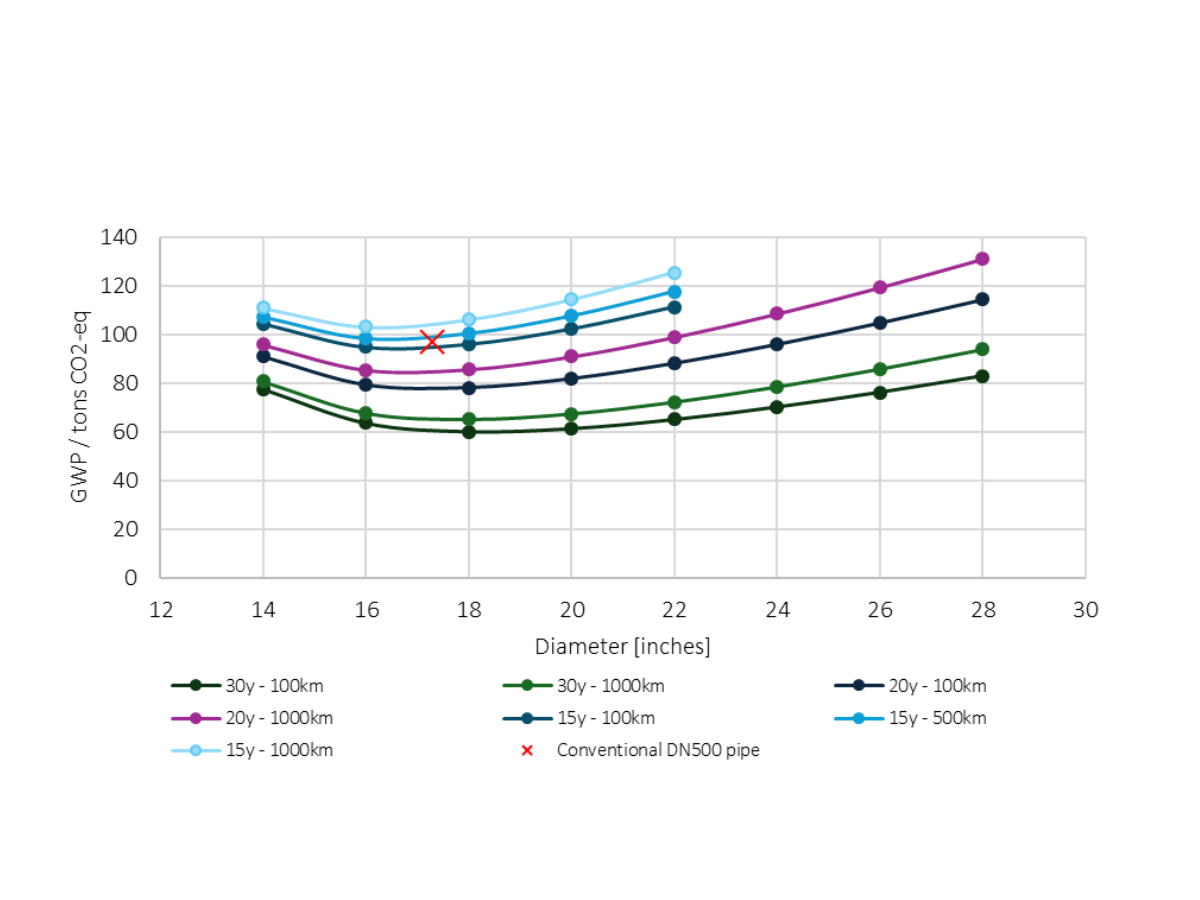
Figure 1. Global warming potential (GWP) of repurposed steel pipes with polyethylene foam insulation and polyethylene casing for different remaining service life and travel distance scenarios. The red dashed line represents the impact from the conventional pipe made entirely from plastics.
District heating and cooling systems, which integrate renewable energy, waste heat and waste cold sources, are emerging as key technologies to drive the decarbonisation of the heating and cooling sector (European Commission (Directorate General for Energy) et al., 2022; Eurostat, 2024). Today, this sector accounts for half of the European Union’s energy demand, yet only 25% of it was supplied by renewable sources in 2022. The construction of district heating and cooling infrastructure includes the production of pipes, which is the main contributor to the environmental impact of the system (Fröling et al., 2004; Oliver-Solà et al., 2009; Vauchez et al., 2023).
As Europe transitions away from fossil fuels, obsolete infrastructure—such as natural gas pipelines—could provide a valuable source of secondary materials (Le Boulzec et al., 2022). Besides material recycling, pipelines could also be repurposed for different uses. So we investigated whether it makes sense to use obsolete pipelines to construct new district heating networks from a technical and environmental perspective. As old pipelines may not always be available in the perfect diameter, we investigated in what range pipes could be considered for repurposing from a technical and environmental point of view and compared them to virgin conventional pipes.
Results show that reusing pipelines is technically feasible in a narrow diameter range close to the design diameter. A 10% reduction in pipe diameter compared to the original design doubles the energy needed for pumping the water in the network, while larger diameters require thicker insulation and increase trench work. Life Cycle Assessment (LCA) confirms that repurposing pipelines for district heating can make sense from an environmental perspective if the available diameter is close to the one chosen by design. In that case, savings among all impact categories of up to 45% can be achieved, despite the fact that the pipelines have to be excavated, transported, insulated, and welded to form the new network. Such benefits can be achieved only if the remaining lifetime of repurposed pipes is in the same range as a new conventional pipe and the transport distance from point of excavation to the new place in the district heating network is as short as possible.
If diameter is too small or too large, transport distance too high, or remaining lifetime too short the environmental benefits diminish or turn into additional impacts. Thus care has to be taken that environmental benefits are actually realized. Furthermore, gas pipelines may also be reused for transporting CO2, H2, or synthetic fuels, or the material recycled for other uses. Thus future studies should investigate which alternative brings the highest benefits towards EU’s net-zero targets overall.
In conclusion, repurposing obsolete steel pipelines shows significant potential to reduce the environmental burden of district heating networks, transform obsolete infrastructure into an essential part of the transition, and introduces an additional circular strategy helping to achieve green energy targets.
By Nicole Wiedmann, Harald Desing – Empa
References
European Commission (Directorate General for Energy), TU Wien, Tilia GmbH, Institute for Resource European Commission (Directorate General for Energy), TU Wien, Tilia GmbH, Institute for Resource Efficiency and Energy Strategies GmbH, Fraunhofer ISI, & Öko Institut. (2022). District heating and cooling in the European Union: Overview of markets and regulatory frameworks under the revised Renewable Energy Directive. Publications Office of the European Union. https://data.europa.eu/doi/10.2833/962525
Eurostat. (2024). Share of renewable energy in gross final energy consumption by sector [Dataset].
Fröling, M., Holmgren, C., & Svanström, M. (2004). Life cycle assessment of the district heat distribution system. The International Journal of Life Cycle Assessment, 9(2), 130–136. https://doi.org/10.1007/BF02978572
Le Boulzec, H., Delannoy, L., Andrieu, B., Verzier, F., Vidal, O., & Mathy, S. (2022). Dynamic modeling of global fossil fuel infrastructure and materials needs: Overcoming a lack of available data. Applied Energy, 326, 119871. https://doi.org/10.1016/j.apenergy.2022.119871
Mahmoud, R. M. A., & Dodds, P. E. (2022). A technical evaluation to analyse of potential repurposing of submarine pipelines for hydrogen and CCS using survival analysis. Ocean Engineering, 266, 112893. https://doi.org/10.1016/j.oceaneng.2022.112893
Oliver-Solà, J., Gabarrell, X., & Rieradevall, J. (2009). Environmental impacts of the infrastructure for district heating in urban neighbourhoods. Energy Policy, 37(11), 4711–4719. https://doi.org/10.1016/j.enpol.2009.06.025
Treiss, F. (2024). Volvo CE stellt neue elektrische Baumaschinen vor. electrive.net. https://www.electrive.net/2024/05/31/volvo-ce-stellt-neue-elektrische-baumaschinen-vor/. Accessed August 2024.
Vauchez, M., Famiglietti, J., Autelitano, K., Colombert, M., Scoccia, R., & Motta, M. (2023). Life Cycle Assessment of District Heating Infrastructures: A Comparison of Pipe Typologies in France. Energies, 16(9), Article 9. https://doi.org/10.3390/en16093912
Westerheide, C. (2024). Komatsu bringt Elektrobagger auf den Markt. electrive.net. https://www.electrive.net/2024/01/03/komatsu-bringt-elektrobagger-auf-den-markt/. Accessed August 2024.
